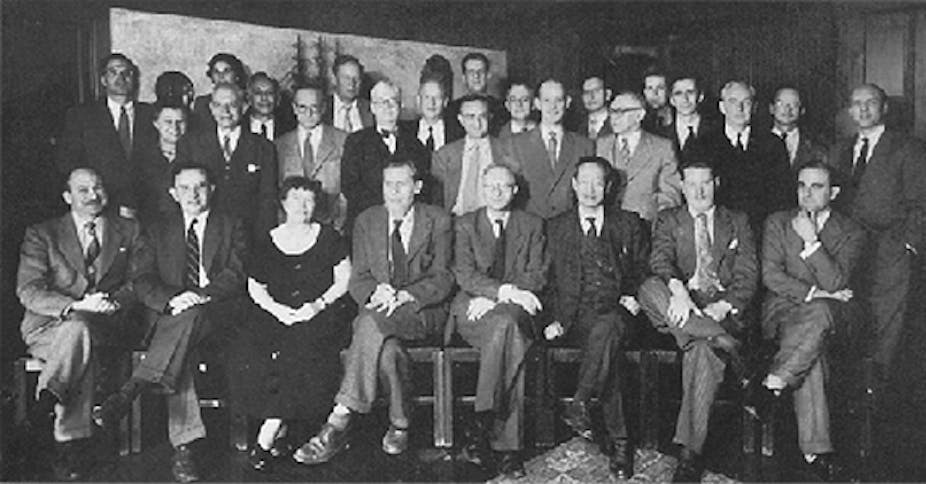Between 1946 and 1953, leading scientists met in New York in the context of the “Macy conferences” at the Beekman hotel, often linked to the emergence of cybernetics. Major scientists of that time like Claude Shannon, John Von Neumann, Warren McCulloch, Walter Pitts, Talcott Parsons, Gregory Bateson, Margaret Mead, Erving Goffman and many others, participated to this set of events aiming at a new science of mind and its control.
Indeed, participants sought a new vision of mind and society. The traumatism of World War II was omnipresent (most of them had lived it directly or indirectly), and the Cold War was starting. Key tools and concepts about information, the value of information, and computer artefacts have now finally produced a new world, in particular a new digital organizational world, which is far removed from their original dreams.
We use the Macy conferences as an entry point to reflect on the long-term evolution of the material underpinnings of information and their relationship with organizing (see also the work of Hayles or Dupuy). However, we do not suggest that Macy was the time and place of the invention of the digital world, but that it is a great window to explore a longer trend that accelerated in the post World War II period.
Macy view of the world: three concepts
Three concepts are at the heart of the Macy conferences: information, value of information, and computer artefacts.
Following from Shannon’s view, information is seen as a flow between a transmitter and a receiver. It is it a quantity of something moving between two points, and the key stake is not to avoid loss of information and noise.
Interestingly, the value of information is grounded in the flow itself and the probability of occurrence of something happening as a result; a flow between a sender and a receiver needing it, for instance to make a decision.
Macy is also a philosophy of the digital, but corresponds to a contemporaneous view of the brain (of the late 1940s) which is at the heart of the electronic brain which emerged at that time. This view is fully consistent with their notion of information. The brain was conceptualized as an abstract logical system (which can be reproduced) made of layers of neurons leading to the “right” representation of the environment and problems to be processed.
This representationist view of the world – there is something out there that we need to represent the “right way” – started imposing a specific understanding of digital transformation. In particular, emotions, perceptions, sense-making and embodiment are not part of the design or description of these information processes.
In parallel, other views of the world (even present at the Macy conferences themselves e.g. with Bateson, MacKay or Bavelas) emerged and were developed by phenomenological, pragmatist and post-Marxist thinkers of the 1930s, 1940s and 1950s – for example James, Vygotsky, Husserl, Dewey, Bergson, Heidegger, Merleau-Ponty, Arendt, Henry and others. Nonetheless, they were side-lined in the design sciences emerging in the post–World War II period and in the social sciences and humanities of the same period.
The post-Macy paradox
Organizational members are now involved in difficult situations in terms of organizing: new modes of digital performativity which are difficult to comprehend and deal with; a transformation of meaning and knowledge in collective activities; and a threat to well-being and happiness as mental activities, as cognition and bodies are increasingly disconnected.
Bearing in mind Macy’s initial vision, it may seem paradoxical that its semiosis (i.e., ways of making sense) can also bring such ruptures. They have taken place over a very long time period, that we chose to explore here through the Macy conferences. These ruptures relate to happiness and well-being more specifically. Indeed, according to the sociologists Bauman and Lyon in their book Liquid surveillance:
“Electronic mediation enables a further distancing between the actor and the outcome than could ever have been imagined in the pre-digital bureaucracy. But it also rests on a shrivelled-up and scarcely recognizable notion of ‘information’ that has been pried free from the person.”
As stated by the French philosopher Michel Serres in his book Petite Poucette, personal mental processes are more and more outsourced as individual cognition is being encapsulated in knowledge systems and retrieval delegated to search engines and social networks. Mental activities and the here and now of the individual body are being separated. The widespread use of “screen images” and the necessity of constant connectedness and reactivity represent a continuous projection to an “elsewhere” and an “after” rather than the “here and now”. This can lead to individual and collective frustration and heighten the risk of mental hyperactivity. Burn out, nervous breakdown, desocialization can be the result of this semiotic process.
With the wisdom of hindsight, all this looks like a real paradox, that we propose to call the post-Macy paradox. Designers and scientists dreamed, with the electronic brain, of a new world, more rational, and far from the passions and horror they experienced during World War II. They did not expect 70 years later that some people would suffer from their amazing philosophical and technical innovations.
Towards new Macy conferences?
We dream of a new Macy conference today as a set of events aiming to shed light on possible ways to reconnect mind and body, and leading to a more harmonious semiosis. For sure, this would not just be about brilliant brains thinking and designing new concepts and new tools. It is time for Science to leave the comfortable rooms of the Beekman hotel and to co-produce its knowledge and techniques within the city… Why not replace the Beekman Hotel by a biohackerspace?
This post summarizes key arguments of an article published in the journal Culture & Organization under the title: “The post-Macy Paradox: How a Search for Heaven Led to Hell in Information Management and Organizing”.

